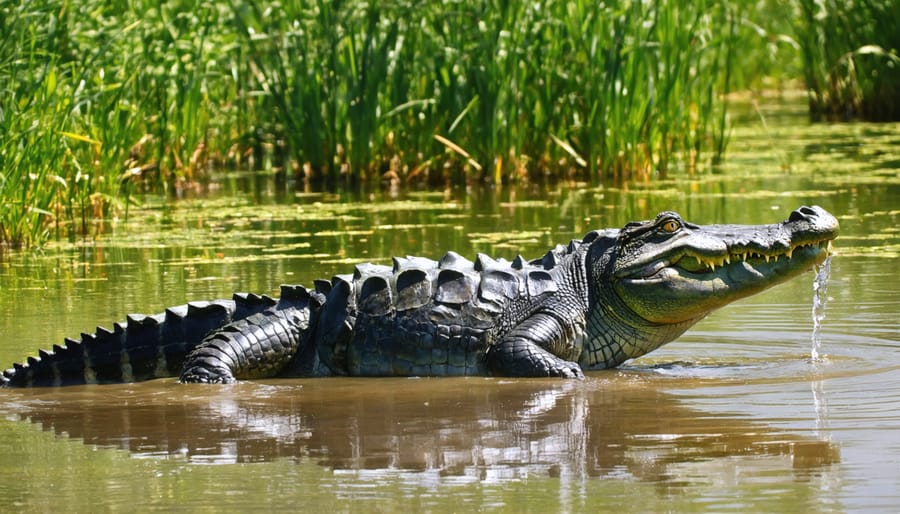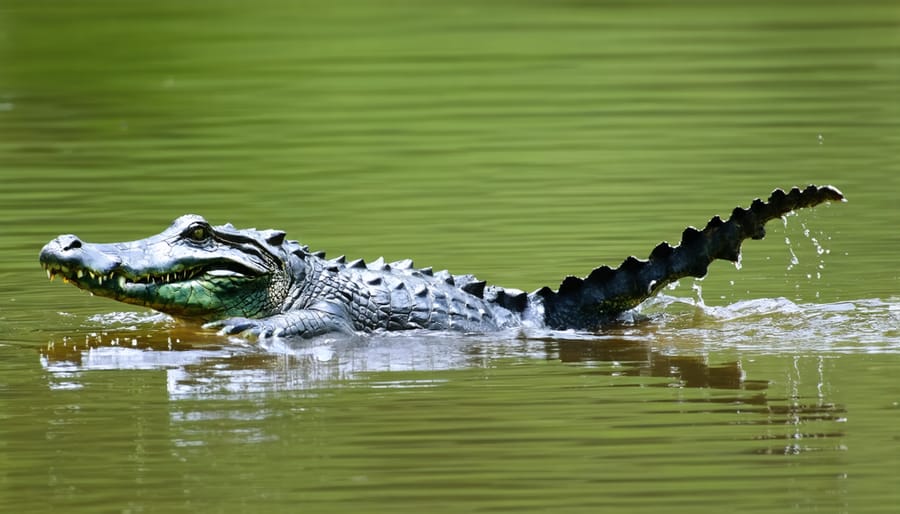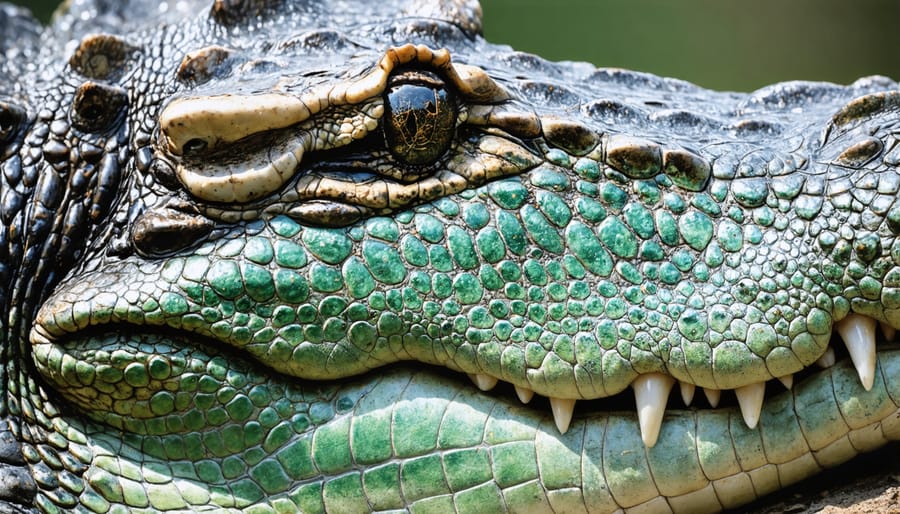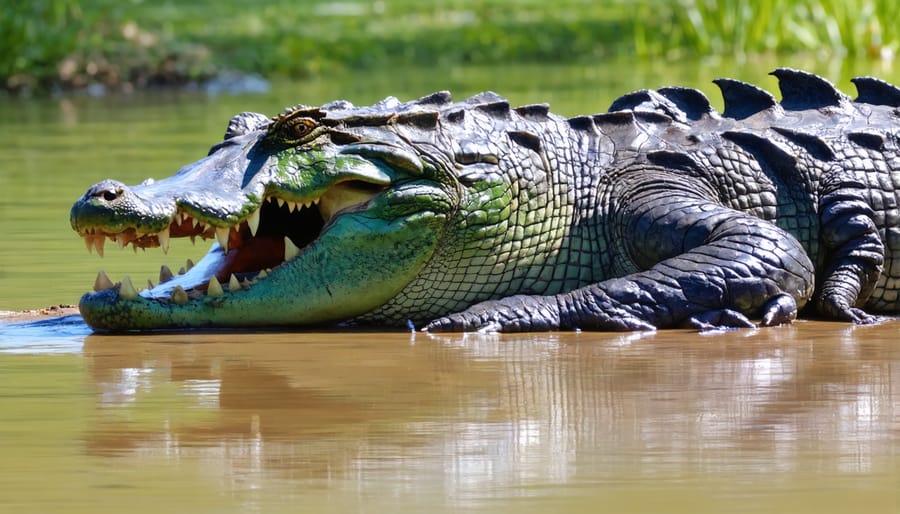
Witness the power of evolution as we explore the remarkable adaptations of the American alligator, a living relic that has thrived for millions of years in its diverse habitat. From armored scales to powerful jaws, specialized sensory organs to seasonal hibernation, uncover the secrets behind this apex predator’s astounding resilience. Join us as we delve into the fascinating world of alligator adaptations, revealing the intricate strategies that have allowed this iconic species to endure through the ages. Prepare to be captivated by the extraordinary story of survival, where ancient instincts meet modern-day conservation efforts in a timeless dance of life in the wetlands.
Physical Adaptations
Powerful Tails and Webbed Feet
The American alligator’s muscular tail and webbed feet are essential adaptations that enable it to thrive in aquatic environments. The tail, which can make up nearly half of the alligator’s total body length, is a powerful propulsive force that allows for efficient swimming and diving. The tail’s side-to-side motion propels the alligator through the water, while also serving as a rudder for steering and quick directional changes. The alligator’s hind feet are fully webbed, acting like paddles to further enhance its swimming prowess. This combination of a strong, muscular tail and webbed feet enables the American alligator to navigate its aquatic habitat with ease, whether pursuing prey, evading predators, or simply moving between different areas of its territory. These adaptations showcase the alligator’s remarkable evolution and its ability to dominate the wetlands and swamps it calls home.

Armored Skin
The American alligator’s thick, armored skin is a remarkable adaptation that has helped the species survive for millions of years. This protective covering is composed of tough, horny scales called scutes, which are made of keratin, the same protein found in human fingernails and hair. The scutes are arranged in rows along the alligator’s back, providing a formidable defense against potential predators and other threats. Beneath the scutes lies a layer of bony plates called osteoderms, which further enhances the alligator’s armor-like protection. This impressive dermal armor not only shields the alligator from physical harm but also helps regulate its body temperature by absorbing and reflecting sunlight. The skin’s rough texture also aids in camouflage, allowing the alligator to blend seamlessly into its swampy habitat. With its armored skin, the American alligator is well-equipped to face the challenges of its environment and maintain its position as a top predator in the wetlands of the southeastern United States.

Specialized Snout and Teeth
The American alligator’s snout and teeth are superbly adapted for its role as an apex predator. The snout is broad and U-shaped, allowing the alligator to maximize its bite force and maintain a secure grip on prey. This powerful bite, estimated at around 2,980 pounds per square inch, enables the alligator to crush the shells of turtles and the bones of larger mammals. The snout also features an array of sensory receptors, including dome pressure receptors, which help the alligator detect and capture prey in murky water.
Alligators possess around 80 teeth, which are continuously replaced throughout their lives. The fourth tooth on the lower jaw is particularly large and visible even when the mouth is closed, serving as an intimidating display. The teeth are conical and sharply pointed, perfect for piercing and holding onto prey. While not designed for chewing, the teeth can tear flesh into smaller pieces that are more easily swallowed. This combination of a powerful bite, sensory-equipped snout, and specialized teeth makes the American alligator a formidable hunter, able to tackle a wide variety of prey in its wetland habitats.
Physiological Adaptations
Ectothermic Metabolism
The American alligator, like all reptiles, is cold-blooded, meaning its body temperature is regulated by the environment. This ectothermic metabolism offers several advantages for survival. By relying on external heat sources, alligators can conserve energy that would otherwise be spent maintaining a constant internal temperature. In cooler weather, they bask in the sun to warm up, while in hotter conditions, they seek shade or cool water to prevent overheating. This flexibility allows them to thrive in a wide range of temperatures.
Moreover, the alligator’s slow metabolism enables it to survive long periods without food. When prey is scarce, they can lower their metabolic rate and live off stored energy reserves. This adaptation is particularly useful during winter months when food is limited and temperatures drop. By slowing down their bodily functions, alligators can essentially enter a state of brumation, similar to hibernation, and emerge when conditions improve. This energy-saving strategy, coupled with their ability to regulate body temperature through behavior, has contributed to the American alligator’s resilience and survival over millions of years.
Ability to Survive in Brackish Water
The American alligator possesses a remarkable adaptation that allows it to thrive in both freshwater and brackish environments: specialized salt glands. Located in the tongue, these glands enable alligators to regulate their body’s salt content by excreting excess salt through their mouth. When an alligator is in a saltwater habitat, the glands actively remove salt from the blood, ensuring the animal maintains a healthy internal balance. This adaptation is crucial for alligators that inhabit coastal regions, where they may encounter varying levels of salinity. By efficiently processing salt, alligators can move between freshwater swamps, marshes, and brackish estuaries without experiencing adverse effects. The ability to tolerate brackish water also expands their potential range and food sources, as they can hunt in a wider variety of habitats. Interestingly, juvenile alligators are less tolerant of saltwater compared to adults, likely because their salt glands are not yet fully developed. As they mature, their ability to regulate salt improves, allowing them to venture into more saline environments. The presence of salt glands in alligators highlights the incredible adaptability of these ancient reptiles and their success in occupying diverse aquatic habitats across the southeastern United States.
Behavioral Adaptations
Hunting Techniques
American alligators are patient and stealthy predators, employing hunting techniques that maximize their chances of catching prey. They often lie motionless in the water, resembling logs or debris, waiting for unsuspecting animals to come within striking distance. This ambush strategy allows them to conserve energy while relying on their powerful jaws and explosive speed to capture prey.
Alligators are opportunistic hunters, feeding on a variety of prey including fish, turtles, birds, and mammals that venture too close to the water’s edge. Their keen eyesight and sensitive receptors on their skin help them detect even the slightest movements or vibrations in the water, enabling them to locate potential prey.
Once an alligator has locked onto its target, it launches a rapid attack, propelling itself through the water with its powerful tail. The alligator’s sharp teeth and strong jaws make quick work of the prey, which is often dragged underwater and drowned before being consumed. This hunting style, perfected over millions of years of evolution, ensures that the American alligator remains a top predator in its wetland habitats, playing a crucial role in maintaining the delicate balance of these ecosystems.
Parental Care
Female American alligators are fiercely protective mothers, ensuring the survival of their young through attentive care and defense. After laying eggs in carefully constructed nests, mothers remain vigilant nearby, guarding against potential predators. As the eggs near hatching, the mother responds to the vocalizations of the hatchlings, helping to excavate the nest and carry the young to the water in her mouth. This gentle retrieval is a striking contrast to the alligator’s powerful jaws. In the water, the mother continues to protect her pod of hatchlings, which can number up to 50. The young alligators remain under her watchful eye for up to two years, benefiting from her protection against predators like birds, raccoons, and even larger alligators. The mother’s presence also deters territorial male alligators that might otherwise prey on the vulnerable hatchlings. This extended period of parental care is crucial for the survival of young alligators, with mortality rates highest in the first few years of life. The dedication of mother alligators showcases the complex social behaviors and adaptations that have enabled this ancient species to thrive in its wetland habitats for millions of years.

Conclusion
The American alligator’s remarkable adaptations have allowed it to thrive in its native habitats for millions of years. From its powerful jaws and armored skin to its keen senses and stealthy hunting techniques, this ancient reptile is a true survivor. Its ability to withstand cold temperatures through brumation and its role as a keystone species in maintaining the health of wetland ecosystems further demonstrate its incredible resilience.
Despite facing numerous threats, including habitat loss and historic overhunting, the American alligator has made a remarkable recovery thanks to successful conservation efforts. Its current status as a species of least concern is a testament to the effectiveness of these measures and the adaptability of this magnificent creature.
As we continue to study and appreciate the American alligator’s unique adaptations, we gain a deeper understanding of the intricate balance within wetland habitats and the importance of preserving these ecosystems. By protecting the alligator and its habitat, we not only ensure the survival of this iconic species but also safeguard the countless other organisms that depend on the same delicate balance for their existence. The story of the American alligator serves as an inspiration for conservation efforts worldwide, reminding us of the resilience of nature and the positive impact we can have when we work together to protect our planet’s biodiversity.
By discovering how keystone species like the American alligator help maintain ecological balance, we uncover the secret ingredient for thriving ecosystems, illustrating the essential role of biodiversity in sustaining life.
jessica
Ava Singh is an environmental writer and marine sustainability advocate with a deep commitment to protecting the world's oceans and coastal communities. With a background in environmental policy and a passion for storytelling, Ava brings complex topics to life through clear, engaging content that educates and empowers readers. At the Marine Biodiversity & Sustainability Learning Center, Ava focuses on sharing impactful stories about community engagement, policy innovations, and conservation strategies. Her writing bridges the gap between science and the public, encouraging people to take part in preserving marine biodiversity. When she’s not writing, Ava collaborates with local initiatives to promote eco-conscious living and sustainable development, ensuring her work makes a difference both on the page and in the real world.
